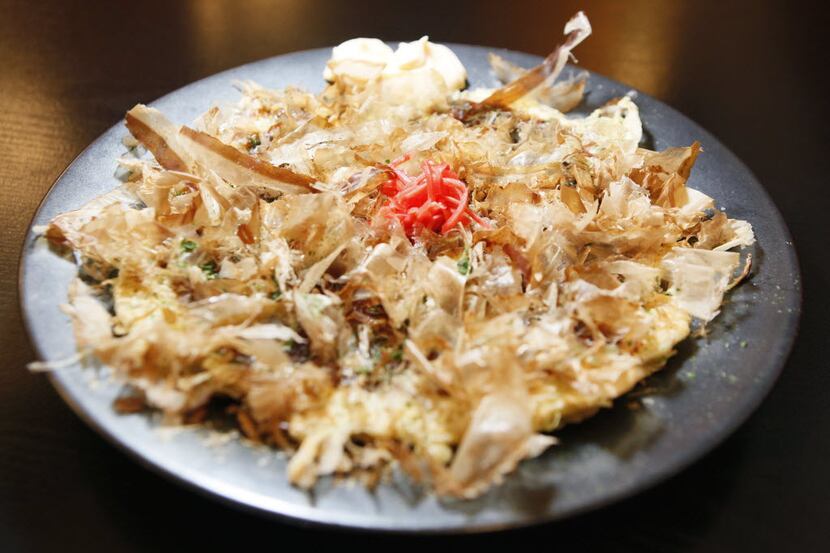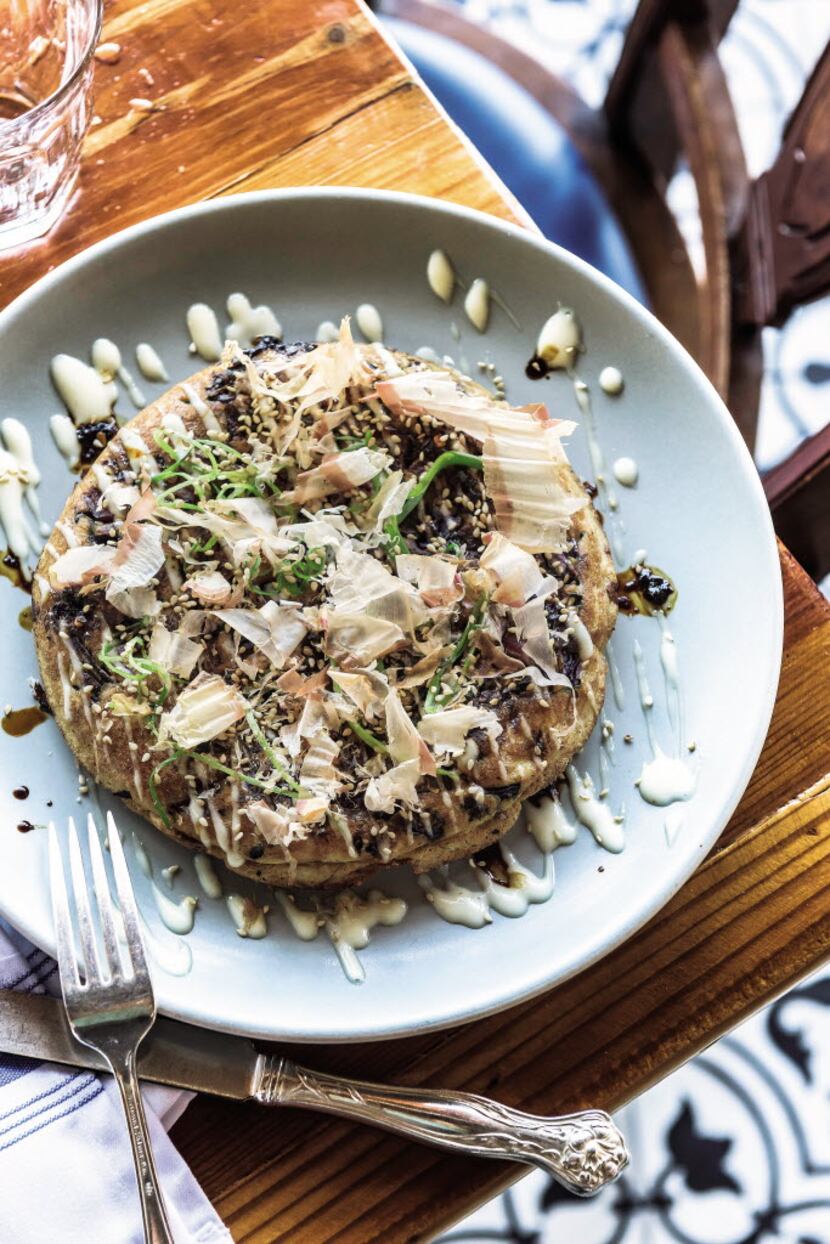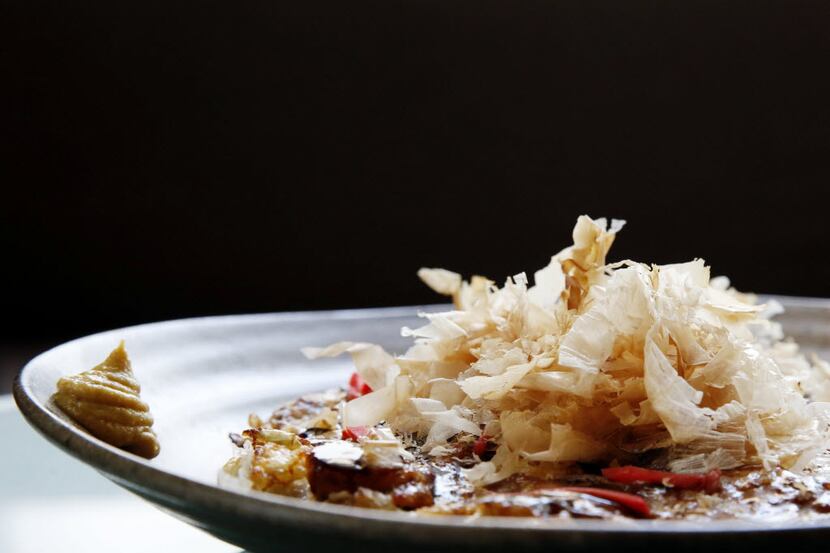Okonomiyaki is ready for its close-up. But are you ready for okonomiyaki?
The thick, savory Japanese pancake – usually filled with cabbage and seafood and topped with bonito flakes – has a reputation for being hard to find in the United States. But, crisp on the outside, luscious on the inside and packed with umami flavor, it can become an object of desire. Or even obsession: A recent story on Public Radio International recounted one aficionado's mission to find the dish, which he discovered only in a San Francisco hole-in-the-wall and a Japanese restaurant in Boston.
He should have looked in Dallas! In the past week I've eaten okonomiyaki in a Carrollton izakaya, an Addison ramen shop and one of Dallas' top four-star restaurants, in the Dallas Arts District. And I haven't even exhausted the North Texas possibilities.
"It's a street food, very casual," says Teiichi Sakurai, who has been featuring a lush version bursting with crab, squid, fresh shrimp and tiny dried shrimp on the specials menu at Tei-An for at least four years. "Originally it came from Osaka, and also Hiroshima is very famous for it - it's a little bit different style."
Shigekazu Tateno has offered it on his menu at Yama Sushi in Lake Highlands since the place opened in 2013. "It's a festival food," he says. "It's like a snack." But it can be more than that; according to both Tateno and Sakurai, okonomiyaki specialty restaurants, where the dish is served as the centerpiece of a meal, are common in Osaka.

Okonomiyaki, which has been translated variously as "what you like grilled" or "what you like cooked" (okonomi means "what you like"; yaki means "grilled" or "cooked"), offers room to play for whoever's creating it. While many versions star seafood, others feature pork; still others include both, along with cabbage, red pickled ginger and sometimes other vegetables. It's always bound with a light pancake-type batter and generally squiggled with teriyaki-like okonomi sauce and mayo, and topped with katsuobushi -- shavings of dried, smoked bonito so light they wave around, appearing to be alive.
No joke. "Four or five times people have returned it to the kitchen because they were scared!" says Sakurai. In keeping with Tei-An's soba (buckwheat noodle) focus, his $14 rendition uses buckwheat flour rather than regular wheat flour. And he garnishes it with a generous flurry of prized, "really, really rare" aonori (green seaweed, also known as green laver) from the Shimanto River in Japan's Kochi Prefecture.
The $8.50 version involving squid, shrimp and cabbage sampled at Hanabi Ramen and Izakaya, a four-month-old spot in Carrollton, was more pancake batter than seafood, meat and veg, but it was likeable enough. (Green laver is mentioned on the menu, too, but if it was there, I couldn't taste it.) The restaurant is a spin-off of the Fort Worth original, which also serves the dish. At Ramen Hakata in Addison, an $8 okonomiyaki filled with the same plus bacon and bean sprouts, was a bust - completely drowned by sweet okonomi sauce and mayo.

Okonomiyaki may turn up where you'd least expect it. When Cody Sharp was executive chef at Filament - Matt McCallister's modern Southern restaurant in Deep Ellum - a "johnnycake okonomiyaki" was a fixture on his menu. It was inspired, he says, by a "very Westernized" one with South Carolina-style barbecue sauce and pulled pork that he tasted at Kevin Gillespie's Gunshow restaurant in Atlanta. "I don't understand why more people don't do it," says Sharp, who describes himself as a "big umami fan." His own stylish johnnycake spin (no longer on the menu, since he left the restaurant) involved cornmeal, ham, charred cabbage, chile flakes and teriyaki sauce aged in bourbon barrels.
"Four or five times, people have returned it to the kitchen because they were scared." - Teiichi Sakurai, chef-owner of Tei-An
Last fall, chef Kirstyn Brewer offered one at Victor Tangos, with winter squash in the batter. "I wanted to keep it as traditional as possible while using local-ish ingredients," she says. "I did a dashi pancake batter loaded with shaved kabocha squash and cabbage. Then poured it over quick sautéed gulf shrimp and shaved Benton's country ham. Then we topped it with bulldog sauce, Kewpie mayo, shaved bonito, pickled ginger, scallion and furikake."
She's about to trot out a new one for the summer, subbing shaved zucchini for the kabocha squash. "Actually, you may have inspired me to run it this weekend," she says. "I am getting some soft-shell crabs, which would be fun to add on top of the pancake!"
I've yet to try the version at Shinguku Station in Fort Worth, which offers the dish on its dinner menu (and at lunchtime by advance request only), or the one at Yama Sushi, both more traditional, no doubt. Tateno says he used to have one on the menu at his Plano restaurant, Yama Izakaya and Sushi, but he took it off the menu. "People get full after a couple slices," he explains, "and at the Plano location I want them to try different dishes." However, it will be on the menu at his new restaurant (as we go to print, he plans to open it June 23 or 24) on Legacy near Central Expressway. Why have it there, if it impedes diners from ordering other things? "The new restaurant is in a Chinatown," he says (it's in the shopping center where you also find Jusgo Supermarket and J.S. Chen's Dimsum and BBQ), "and I notice that a lot of Chinese customers like okonomiyaki."
They're not the only ones, I reckon: There's an entire website devoted to the dish, Okonomiyaki World.

